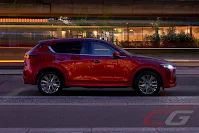Apparently, one of the biggest changes to the 2022 Mazda CX-5 is something that you don’t see. While Mazda’s compact SUV does get reasonably visible aesthetic changes to its exterior and added equipment to its interior, the carmaker also used this opportunity to modify its platform and even all-wheel drive system.
The improvements are easy to miss; after all, it was just relegated to a couple of lines in the official press release. When talking about the platform, this is what Mazda had to say:
Updates to the suspension include improvements to the dampening control structure and increased frame rigidity, which will help suppress unpleasant vibrations, reduce road noise, and help to provide a quieter cabin and higher quality of ride comfort. Overall, these enhancements will help the driver feel more connected to the enjoyable driving experience.
As for the all-wheel drive, now standard in some markets:
Some model grades equipped with i-Activ AWD further benefit from an Off-Road Mode, which makes driving feel more natural on un-made and slippery surfaces…Mazda’s next generation of Skyactiv-Vehicle Architecture has now been applied to the 2022 CX-5.According to Driving.CA, this points to the CX-5 getting an upgraded version of its predictive all-wheel drive system, a system first introduced in Mazda’s seventh-generation models—the Mazda3 and the CX-30.
The new system will still be predictive in that like the current i-Activ AWD, it uses sensors scattered around the car to determine if any power split is necessary and to what degree. It also monitors other things up to 200 times per second such as windshield wiper use, brake fluid pressure, exterior/interior temperature, steering wheel inputs (27 in all) to make it more predictive.
The goal of the new i-Activ AWD system is down to one thing: improved fuel efficiency.
Per the story:
One of the key differences with this newer version of Mazda’s i-Activ AWD is that it allows for 100 percent front wheel drive in appropriate conditions for improved efficiency. To make up for the rear axle not being permanently pre-loaded as in the previous system [the current system defaults to a 98 front, 2 percent rear split], the rear wheels are kept in a slight state of overdrive when not engaged, rotating 1.1 percent faster than the front wheels. When the clutch plates in the differential connect to activate the rear wheels, this faster rotation allows the connection to take place faster and respond to inputs immediately.The system gathers information on vehicle dynamics in real-time—partly through Mazda’s G-Vectoring Control technology introduced in 2016—to assess the active vertical load on each tire, thereby calculating its grip level. The system can then determine how much torque each axle needs in the moment for optimal performance, aiming to deliver that torque before it’s actively required.And here’s the really nitty-gritty stuff: a rubber damper inside the power take-off unit reduces fluctuations in rear input torque, which also helps to improve fuel efficiency. Plus, mechanical loss through the rear differential is reduced by switching the ultra-low-viscosity oil delivery to a top-down on-demand system.
For now, Mazda hasn’t elaborated on whether the 2022 CX-5 does benefit from the new i-Activ AWD system. But if this story is true, then the compact SUV is truly enjoying a whole waft of updates that extend beyond design tweaks.
With the Philippines sourcing its CX-5 from Malaysia, it’s still not known on whether we’ll be enjoying the global model’s updates. It’s worth noting that in Mazda’s home market of Japan, they have yet to officially announce the updated CX-5, a sign perhaps that Japan is moving to a different direction as far as product refreshes are concerned.




No comments:
Post a Comment
Feel free to comment or share your views. Comments that are derogatory and/or spam will not be tolerated. We reserve the right to moderate and/or remove comments.